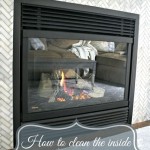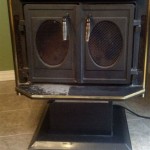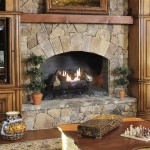How To Clean Soot From Fireplace Brick
Fireplaces, while adding aesthetic appeal and warmth to a home, inevitably accumulate soot on their brick surfaces. Soot, a byproduct of incomplete combustion, is a dark, powdery or flaky substance composed primarily of carbon. Its accumulation can detract from the fireplace's appearance and, in some instances, contribute to indoor air quality concerns. Cleaning soot from fireplace brick, while potentially labor-intensive, is a manageable task that can significantly improve the look and cleanliness of the hearth. This process requires specific materials, appropriate safety precautions, and a systematic approach to ensure effective soot removal without damaging the brick.
Before initiating any cleaning process, it is crucial to prioritize safety. Soot can contain potentially harmful substances, and some cleaning agents can be irritating. Therefore, the following safety measures are essential: Wear appropriate personal protective equipment (PPE), including gloves, a dust mask or respirator, and eye protection. These items minimize skin contact, inhalation of soot particles, and eye irritation. Ensure adequate ventilation by opening windows and doors to facilitate airflow and prevent the buildup of fumes from cleaning solutions. Cover surrounding furniture and flooring with drop cloths or plastic sheeting to protect them from soot and cleaning agents. A thorough preparation of the area is paramount to minimizing the spread of soot and protecting the surrounding environment.
Preparing the Fireplace and Gathering Supplies
The initial stage of soot removal involves preparing the fireplace for cleaning. Begin by removing any loose debris, such as ashes and partially burned wood, from the firebox. A shovel and a sturdy trash bag are effective for this task. Use a dry brush or vacuum cleaner with a brush attachment to remove as much loose soot as possible from the brick surface. This step reduces the amount of soot that will interact with cleaning solutions, thereby increasing their efficacy. The preliminary dry cleaning minimizes the potential for creating a muddy or difficult-to-manage slurry when wet cleaning methods are applied. Once the loose soot is removed, gather the necessary cleaning supplies. These typically include a stiff-bristled brush (a scrub brush or masonry brush is ideal), a sponge, buckets, trisodium phosphate (TSP) or a TSP substitute, water, and possibly a specialized brick cleaner for stubborn stains. A putty knife or scraper may also be helpful for dislodging particularly thick deposits of soot.
The choice of cleaning solution is crucial for effective soot removal and depends on the severity of the soot accumulation and the type of brick. Trisodium phosphate (TSP) is a powerful cleaning agent that effectively cuts through grease and soot. However, it is caustic and should be handled with caution, following the manufacturer's instructions carefully. TSP substitutes are available and are generally less harsh, making them suitable for lighter soot deposits or for individuals sensitive to strong chemicals. Specialized brick cleaners are formulated specifically for masonry surfaces and may contain a blend of detergents and solvents designed to penetrate and dissolve soot. Always test any cleaning solution in an inconspicuous area of the brick to ensure it does not cause discoloration or damage before applying it to the entire surface. Water is an essential component of the cleaning process, used both for mixing cleaning solutions and for rinsing the brick surface. Clean, warm water is generally most effective for dissolving soot and rinsing away residue. The quantity of water required will depend on the size of the fireplace and the extent of the soot accumulation.
The selection of appropriate tools is equally important. A stiff-bristled brush is essential for scrubbing the brick surface and dislodging soot particles. Choose a brush with durable bristles that can withstand vigorous scrubbing without becoming damaged. A sponge is useful for applying cleaning solutions and rinsing the brick. Opt for a sponge that is absorbent and easy to wring out. Buckets are needed for mixing cleaning solutions and holding clean water for rinsing. Use separate buckets for each purpose to avoid cross-contamination. A putty knife or scraper can be used to remove particularly thick or stubborn deposits of soot. Exercise caution when using these tools to avoid scratching or damaging the brick surface. A thorough evaluation of the tools ensures that removal of soot will be more efficient and the work will be done faster.
The Soot Removal Process
After preparing the fireplace and gathering supplies, the next step is to apply the cleaning solution. Mix the chosen cleaning agent with water according to the manufacturer's instructions, or follow a recipe for a homemade cleaning solution. If using TSP, typically a ratio of 1/2 cup of TSP per gallon of warm water is recommended. If using a specialized brick cleaner, carefully read and follow the product's instructions. Apply the cleaning solution to the brick surface using a sponge or brush. Work in small sections, allowing the solution to dwell on the soot for a few minutes to loosen the deposits. Avoid applying the solution too liberally, as excessive moisture can penetrate the brick and potentially cause damage.
Once the cleaning solution has had time to dwell, scrub the brick surface using a stiff-bristled brush. Apply firm, even pressure, working in a circular motion to dislodge soot particles. Pay particular attention to areas with heavy soot accumulation. Regularly rinse the brush in clean water to remove accumulated soot and maintain its cleaning effectiveness. For particularly stubborn soot deposits, use a putty knife or scraper to gently scrape away the soot. Exercise caution to avoid scratching or damaging the brick surface. If necessary, reapply the cleaning solution and repeat the scrubbing process. The key is to break down the soot and let the cleaning solution do its work.
After scrubbing, rinse the brick surface thoroughly with clean water using a sponge or hose. Ensure that all traces of the cleaning solution and dislodged soot are removed. Repeat the rinsing process as needed until the water runs clear. Use a clean sponge to wipe down the brick surface and remove any remaining residue. Allowing the fireplace brick to air dry completely. This may take several hours or even overnight, depending on the humidity and ventilation. A fan can be used to expedite the drying process. Once the brick is completely dry, inspect the surface for any remaining soot or stains. If necessary, repeat the cleaning process to address any persistent areas. The cleaning process should be done methodically and properly to ensure safety.
Addressing Stubborn Soot Stains and Additional Cleaning Tips
Despite best efforts, some soot stains may prove particularly stubborn and require additional treatment. For these stains, consider using a more concentrated cleaning solution or a specialized brick cleaner designed for heavy-duty soot removal. Apply the concentrated solution directly to the stain, allowing it to dwell for a longer period before scrubbing. Alternatively, create a paste of baking soda and water and apply it to the stain. Allow the paste to dry completely before scrubbing it off with a brush. Baking soda is a mild abrasive that can help to lift stubborn stains without damaging the brick.
Another effective method for removing stubborn soot stains is to use a steam cleaner. The high-temperature steam can penetrate the soot and loosen it, making it easier to remove with a brush. Follow the manufacturer's instructions for using the steam cleaner and exercise caution to avoid burns. For particularly challenging stains, consider consulting a professional cleaning service specializing in fireplace restoration. These professionals have access to specialized equipment and cleaning agents that can effectively remove even the most stubborn soot stains.
To maintain a clean fireplace and prevent excessive soot accumulation, regular cleaning is essential. Clean the fireplace at least once a year, or more frequently if it is used heavily. Regularly remove ashes and debris from the firebox. Ensure that the fireplace damper is functioning properly to prevent smoke and soot from entering the room. Consider using seasoned firewood, as it burns more cleanly than green wood and produces less soot. Periodic inspections of the fireplace and chimney are crucial for identifying and addressing potential problems, such as creosote buildup, which can increase the risk of chimney fires. By practicing these preventive measures, the accumulation of soot will be significantly reduced.

How To Clean Soot Off Brick Fireplaces Anew

How To Clean Fireplace Bricks Simple Practical Beautiful

How To Clean A Fireplace Diy Basics

How Fo I Remove Fireplace Soot Smoke Hometalk

Best Way To Clean A Fireplace Stacy Risenmay

How To Clean Fireplace Brick Soot Marks And Grime Hometalk

How To Clean Fireplace Bricks 9 Steps With S Wikihow

Cleaning Soot Above Your Fireplace

How To Clean Brick Fireplace Royal Stone Care

4 Ways To Clean Soot From Brick Wikihow
Related Posts








